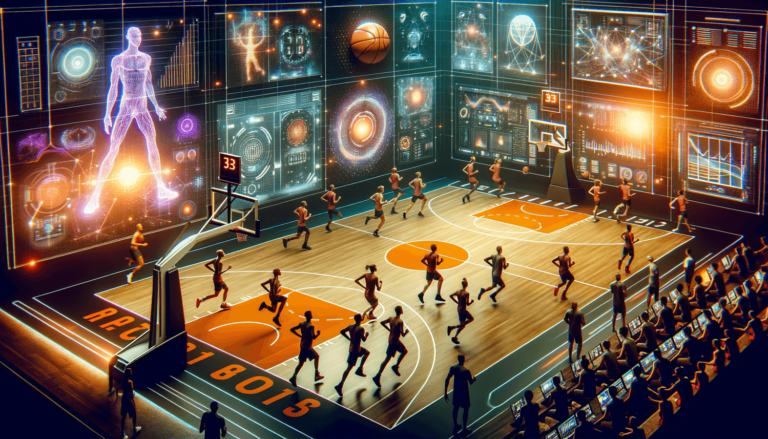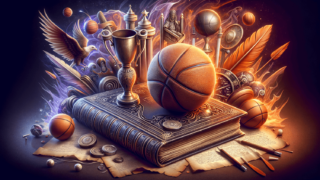
Impact of Technology on Basketball Training and Performance
Written by: Basketball Universe
Last updated:

As the age of technology continues to evolve at a breakneck pace, its influence in the world of sports – particularly basketball – has been nothing short of transformative. In this compelling dive into the ‘Impact of Technology on Basketball Training and Performance,’ we’ll examine how innovative gadgets, software, and analytics have revolutionized the way players hone their skills, coaches strategize, and teams maximize their potential. Get ready to lace up your high-tops and connect to the digital court, where groundbreaking advancements merge seamlessly with the players’ passion for the game – and the pursuit of greatness soars to new heights!
Impact of Technology on Basketball Training and Performance
Technology has significantly changed basketball training and performance by introducing advanced tools and analytics for skill improvement, injury prevention, and game strategy. Wearable devices and motion tracking systems provide real-time data and feedback, allowing athletes to fine-tune their techniques. Coaches and teams make use of video analysis software to review player performance and devise more effective strategies. Moreover, sports analytics help in identifying key performance indicators (KPIs) and understanding player dynamics in greater depth, thereby enhancing overall team performance on the court.
The Rise of Wearable Tech: Tracking Performance, Advancing Skills
Wearable technology, once the stuff of science fiction, has become a reality for basketball players and coaches alike. These innovative devices, such as heart rate monitors, GPS, and accelerometer-equipped smartwatches, provide valuable data on physical conditioning, player movement, and overall performance.
Heart Rate Monitors
Heart rate monitors are indispensable tools for understanding player load and conditioning, as they track cardiovascular response and energy expenditure. This invaluable data allows coaches and trainers to tailor workout regimens and recovery plans to each player’s unique needs, resulting in better-prepared athletes, reduced injury risk, and improved game-day performance.
GPS Tracking
Global Positioning System (GPS) tracking technology helps map a player’s on-court movement, providing insight into essential aspects such as agility, speed, and distance covered. With easy visualization of player movements, coaches can design more efficient drills that replicate in-game scenarios, thereby elevating on-court reactions and decision making.
Accelerometer-equipped Smartwatches
By measuring an athlete’s acceleration and force, accelerometer-equipped smartwatches allow coaches to evaluate player explosiveness and agility. Identifying areas for improvement, devising custom drills to target those weak points, and comparing pre- and post-training data all contribute to the ongoing growth and honing of an athlete’s skills.
Enter the Sports Analytics Era: Decoding Data for the Win
It’s hard to imagine that until recently, coaches relied on their intuition and innate understanding of the game to make strategic decisions. Thanks to sports analytics, however, today’s coaches and teams have access to a treasure trove of empirical data, illuminating every aspect of the game and opening up new realms of possibility. From player efficiency ratings to advanced offensive and defensive metrics, sports analytics play an increasingly critical role in basketball training and performance.
Analyzing Offensive Metrics
One of the essential aspects influencing basketball performance is a team’s ability to score. As a result, measuring and understanding offensive efficiency is crucial. Advanced stats like points per possession, effective field goal percentage, and assist-to-turnover ratio are just a few examples of metrics that enable teams to fine-tune their offensive playbook, space the floor more effectively, and create easier scoring opportunities.
Getting Defensive: Stopping Opponents in their Tracks
As the adage goes, defense wins championships, and embracing sports analytics can significantly impact defensive performance. Essential defensive stats—such as opponent points per possession, defensive rebounding rate, and steal percentage—provide coaches with the data necessary to develop tactics to shut down opponents and dictate the tempo of the game.
Basketball History & The Evolution of Player Evaluation
Throughout basketball history, player evaluation has evolved from a subjective, eye-test-based approach to one that prioritizes empirical evidence. Stats like Player Efficiency Rating (PER), Win Shares (WS), and Real Plus-Minus (RPM) allow teams to evaluate players in ways that were unimaginable just a few decades ago. This wealth of quantifiable data has revolutionized the draft process, trade negotiations, and contract evaluations, ensuring that teams make more informed decisions and avoid costly mistakes.
Unlocking the Power of Video Analysis
Video analysis software has become a game-changer in the world of basketball training and performance. This technology arms coaches and players with an unparalleled view into the intricacies of the game, providing a detailed breakdown of players’ actions and decision-making, as well as opposition tendencies and weaknesses.
Player Skill Development
Through video analysis, coaches and players can scrutinize each play and understand the strengths and weaknesses of their game. By dissecting individual skill sets, coaches can develop targeted training regimens to address areas requiring improvement, enhancing the player’s overall versatility and strength on the court. For players, reviewing video offers opportunities for self-reflection and deeper understanding of their performance, fueling a drive to become better in every aspect of the game.
Opposition Scouting: Knowing your Enemy
In the quest for victory, knowing your adversary is half the battle. Video analysis enables teams to break down opponents’ playing style, strategies, and tendencies, identifying weaknesses and formulating precise game plans to exploit them. In addition, teams use this technology to prepare for specific matchups, giving them a strategic edge before even stepping onto the court.
High-tech Facilities: Training Centers of the Future
As technology continues to reshape the landscape of basketball, so does the infrastructure supporting it. State-of-the-art training centers equipped with the latest gadgets and systems are becoming the norm, creating environments that inspire transformational growth for athletes striving for supreme performance.
Smart Courts: Revolutionizing the Practice Experience
Imagine a basketball court that not only tracks every movement, shot, pass, and rebound but also provides real-time, individualized feedback to enhance players’ development. Welcome to the world of smart courts. These high-tech practice facilities, equipped with sensor technology and video cameras, provide personalized data and feedback on player efficiency, shot selection, and even shot trajectories. As a result, players can optimize their training sessions, making every moment count toward their improvement.
The Science of Recovery
Optimal training isn’t just about pushing physical boundaries—it’s also about understanding and prioritizing the science of recovery. Today’s tech-driven training centers invariably feature cutting-edge recovery facilities, including cryotherapy, float tanks, and state-of-the-art nutritional facilities, helping athletes maximize the impact of their training while minimizing downtime.
As we’ve explored, the impact of technology on basketball training and performance has been nothing short of extraordinary — and we’re only just scratching the surface. As technological advances continue to accelerate, the future of basketball training and performance promises to be even more exciting, innovative, and transformative. No doubt, the players that follow in the footsteps of basketball history’s legendary athletes will reap the rewards of these innovations, pushing the boundaries of the game to new heights.
Virtual Reality: Pushing the Realms of Basketball Training
Virtual reality (VR) technology is making significant inroads into the world of basketball training and performance. With its immersive, three-dimensional environments, VR allows athletes to experience game-like scenarios, develop their skills, and hone their decision-making without ever stepping foot on the court. Let’s explore the key uses of VR technology in basketball training and performance.
Simulated Practice
Through VR, basketball players can participate in fully immersive, simulated practice sessions. The technology allows athletes to experience a variety of defensive and offensive scenarios, precisely replicating in-game situations. With VR, players can respond to different stimuli and challenges, expanding their game knowledge, refining their strategies, and enhancing decision-making skills under pressure.
Reinforcing Mental Toughness
Mental toughness is a make-or-break component of basketball performance. Just ask the legends of basketball history. Virtual reality is a powerful tool to boost players’ mental capacity, resilience, and ability to handle pressure. By simulating high-pressure scenarios in a controlled environment, athletes can develop coping mechanisms and improve focus, ultimately priming them for high-stress situations during a real game.
Rehabilitation and Injury Prevention
For injured athletes, rehabilitation can be a long and arduous process. VR offers an innovative solution for maintaining physical fitness and mental sharpness during this challenging period. By replicating game scenarios, players can maintain their muscle memory and engage in cognitive training. Additionally, integrating VR technology into recovery programs helps reduce the risk of further injury through guided physical therapy sessions and biomechanical analysis.
Beyond the Game: The eSports Boom
While not directly related to on-court performance, the booming eSports industry has had a significant impact on basketball’s landscape. The rise of NBA 2K and other basketball-based video games has transformed how fans engage with the sport, creating new communities and opportunities for players, coaches, and organizations alike.
Building Basketball Communities
Online gaming platforms have provided basketball enthusiasts with unparalleled opportunities to connect, collaborate, and compete, fostering a vibrant global community. eSports tournaments have surged in popularity, further democratizing the sport and promoting its core values of teamwork, communication, strategic thinking, and, of course, FUN.
Developing Digital Skills, Tactics, and Strategy
As eSports continue to grow in popularity, an unexpected byproduct has emerged: gamers are translating their digital skills, tactics, and strategies onto the basketball court. The strategic, analytic, and mental aspects of basketball video games parallel those required for on-court success, allowing gamers to develop their basketball IQ and cognitive skills through digital competition.
No matter where the future of technology takes basketball, players, coaches, and fans alike can look forward to uncharted territories of innovation and excitement. As we’ve explored, the impact of technology on basketball training and performance is profound, driving improvement while simultaneously creating new opportunities, communities, and platforms for the sport to thrive. With this in mind, it’s safe to assume the legends of tomorrow will emerge from a technologically enhanced environment that inspires constant evolution and growth.
Frequently Asked Questions: Technology in Basketball Training and Performance
As the impact of technology on basketball training and performance continues to evolve, it can be challenging to keep track of all the advancements and insights. We’ve compiled a list of frequently asked questions to help clarify the relationship between technology and basketball, so you can stay informed and in-the-know about this rapidly developing field.
1. How does wearable tech improve basketball performance?
Wearable technology provides real-time data on a variety of physical and performance indicators. These devices, such as heart rate monitors, GPS trackers, and accelerometers, give players and coaches valuable insights into areas like cardiovascular fitness, movement, and explosiveness, helping to design more targeted and effective training regimens to enhance overall performance.
2. What are some examples of sports analytics used in basketball?
Sports analytics involves using extensive data sets and statistics to explore in-depth player and team performance. Examples include Player Efficiency Rating (PER), which measures a player’s overall impact on the game, Win Shares (WS), an estimate of the number of wins a player contributes, and Real Plus-Minus (RPM), a stat that helps determine the net point differential per 100 possessions when a player is on the court.
3. Can video analysis software help basketball players improve their skills?
Yes, video analysis software allows coaches and players to review training sessions and games, providing valuable insights into players’ skills, strengths, and weaknesses. By dissecting individual performance and analyzing plays, coaches can devise training regimens tailored to improving each player’s unique skill set and overall performance on the court.
4. What are smart courts, and how do they benefit basketball training?
Smart courts are high-tech practice facilities equipped with sensor technology and video cameras, providing real-time data and feedback on player efficiency, movement, shot selection, and more. These cutting-edge practice environments help players to optimize their training sessions, making every moment count toward improvement and skill development.
5. Can virtual reality (VR) help basketball players develop mental toughness?
Virtual reality technology immerses players in high-pressure game-like scenarios, providing opportunities to develop coping mechanisms and improve focus under stress. By simulating these challenging situations in a controlled environment, players can build resilience, mental toughness, and the ability to perform under pressure on the court.
6. How do eSports and video games impact basketball?
While not directly related to on-court performance, the booming eSports industry has changed how fans engage with basketball — creating new communities, opportunities, and platforms for players, coaches, and organizations. Moreover, gaming platforms have expanded fans’ understanding of the sport and helped develop their cognitive skills, basketball IQ, and strategic thinking.
7. How does technology contribute to injury prevention in basketball?
Technology contributes to injury prevention by providing real-time data on physical conditioning, player workload, and movement. This data allows coaches and trainers to design targeted training regimens and recovery plans tailored to each player’s needs. Furthermore, using VR for rehab helps maintain players’ muscle memory and provides guided physical therapy sessions that lower the risk of further injury.
8. Can technology help improve team strategy in basketball?
Yes, the analyzing data from wearable tech, video analysis, and sports analytics allows teams to better understand their strengths, weaknesses, and opponents. This knowledge helps coaches and players make more informed strategic decisions, develop game plans, and optimize their approach to both offense and defense.
9. What types of tech are used in cutting-edge basketball recovery facilities?
State-of-the-art recovery facilities in basketball include technologies like cryotherapy, which involves exposing the body to extremely cold temperatures to reduce inflammation; float tanks, where athletes can relax and recuperate in sensory deprivation environments; and advanced nutritional facilities that provide tailored nutrition plans to aid in the recovery process.
10. How does technology promote basketball communities?
Technology helps create and foster vibrant basketball communities by connecting enthusiasts through online platforms and gaming. eSports tournaments and digital discussion forums cultivate a worldwide audience for the sport, expanding its reach and providing opportunities for global teamwork, communication, and competition.
Featured Posts
- No pillar pages found.




